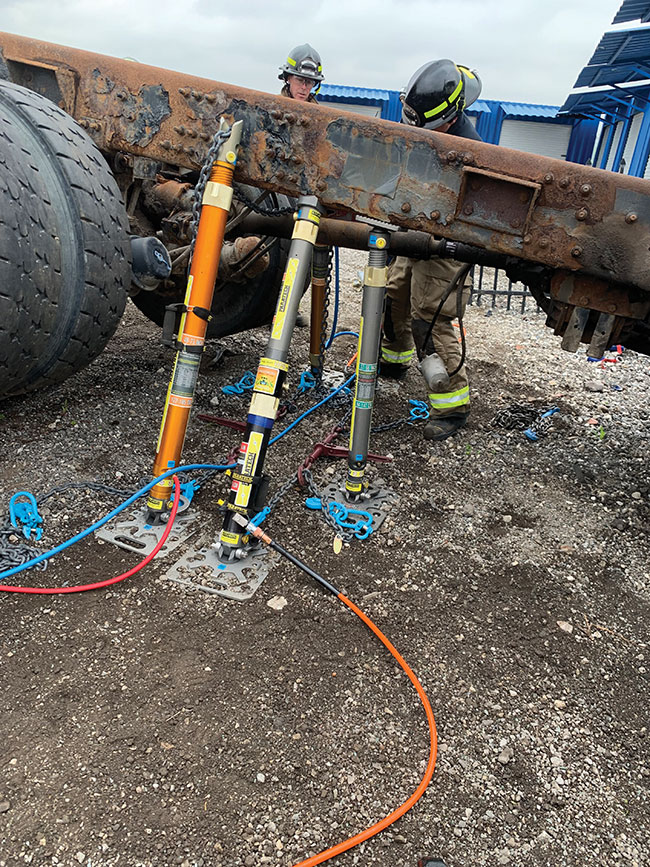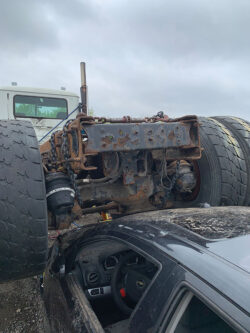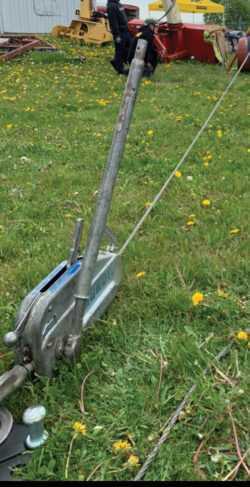
Extrication Tips: Mitigate chaos with simplicity
Chad Roberts
Features The strut on the right is placed early in the operation to stop the crush of the larger vehicle.
The strut on the right is placed early in the operation to stop the crush of the larger vehicle. In the last couple Extrication Tips, I focused on the different types of struts, their weight rating and possible application of each. After exploring the different options, it was very apparent that this type of equipment can be used in many different ways to make our job safer, and more efficient. While trench rescue and structural collapse were very suitable applications for some of our “heavy lifting” struts, the most common situation these might be seen or used in is for just that; heavy lifting. With that being said, I’m going to provide you with a simple approach to one of the more common uses of your heavy struts, the vehicle under ride.
Now don’t get me wrong, by simple approach I don’t try and pretend that these operations and types of calls are easy, they are far from it. However, I feel that some of the most complicated calls can be mitigated by simple approaches.
The operation that we’re going to simulate for the purpose of this article is the passenger vehicle that has made high speed contact with the back end of a transport truck that has consequently trapped the driver’s lower extremities under the weight of the trailer load that is now sitting on top of the passenger vehicle (a very common occurrence that is happening more often due to increasingly distracted drivers on the road).
Let’s break it down and make this chaotic scene into a more manageable operation.
The first step after your initial size up and radio communications is “identifying the load”. The importance of this cannot be overstated. Before committing crew members to an already dangerous scene, we must identify what the load is carrying. This is not only important from the hazardous material aspect of the call, but can be very helpful in identifying how much weight you may be required to lift off of your patient. Are they hauling a full load or have they just off loaded and riding empty? Always assume the load is full if it’s not easily recognized. With the rising costs of fuel, it’s becoming rarer for any trucks on the road to be hauling an empty trailer. Another important thing to note is whether it is a live load. This can be anything from actual livestock or animals, to fluid in a container. Not to say these loads can’t be lifted, but we will need to predict direction they may shift and plan for it when we finally do lift the load.

The chain wrapping on the larger vehicle is another way to capture the load and not lose any lifting progress.
The next step is “stopping the crush”. When an under ride or large load is placed upon a vehicle or other object, there will always be the initial crush. What we sometimes forget to understand is that the larger weight will continue to crush downward at a rate we might not even notice if we don’t find a way stop this action. This can be as simple as cribbing the larger load and the void spaces that are still remaining between the two objects. More complex but effective methods of accomplishing this task would be with the use of air bags or even a properly rated strut to simply snug up against the larger object so there is no further crushing on our patients.
After we finish mitigating the downward crushing as best as possible, our next step will be to facilitate and further create space between the two objects involved by “capturing the suspension” of the smaller vehicle. To do this we will use a ratchet strap from the left front tire to the right front tire. Once they are strapped, the ratchet should be tightened as much as possible to capture and/or partially load the suspension of the smaller vehicle. The same operation can be done on the rear tires to further capture the travel.
One further option that can create a little more space is letting the air out of the tires. Now that we’ve captured the suspension and lowered the vehicle as much as possible without lifting intervention, we may have even created enough space to free our patient or at the very least capture the suspension from travelling back upwards once we lift the heavier load. When doing lifting operations, we are only going to lift as much as we need, so the last thing we want to do is lose some of the overall lift when our suspension unloads as we release the heavier object from it.

Once the load is suspended, the smaller vehicle can removed with a grip hoist as shown bef
If the suspension capturing and air out of the tires does not alleviate our patient entrapment or create enough space to remove the vehicle from out under the load, we will have to move to our fourth step with is “lifting the load”.
How this will be accomplished will be up to your specific departments training, equipment and sops. Lifting operations may include air bags, struts and possibly even the use of a heavy tow operator. No matter the chosen operation of your specific department, we must remember to capture and stabilize our lift as we go and choose the operation that will be the safest, and most efficient to lift our heavier load just enough to free our patient and/or move the vehicle.
This leads us to our last step, which will generally be a judgement call based on the situation at hand and that is whether or not we proceed with the extrication with the smaller vehicle underneath the suspended heavier load, or if we move this smaller vehicle out of the way. My personal go-to is to remove the smaller vehicle with a winch or a grip hoist if we can before we commence the extrication. This will keep the patient and rescuers out of any further danger in the event the lifting device fails or the load shifts. However, like most of our calls, we must let this decision weigh heavily based on our patient’s condition and positioning.
With lifting operations, we can ultimately say that they will all be very different and extremely challenging to even the most competent rescue teams. Using these five steps will give you a quick reference to properly run these scenes. We must also remember that we have to keep many things in mind, mainly patient and rescuer safety when choosing our method of attack.
In the next article I will talk about some of the more specific things we’ll need to keep in mind when completing lifting operations.
Chad Roberts is a firefighter in Oakville, Ont. He is a member of the Oakville extrication team and competes and trains across North America. Contact Chad at chadroberts12@gmail.com.
Print this page
Advertisement
- Regional District of Nanaimo wants policy for recognition of volunteer firefighters
- Back to basics: Firefighter survival — Rope bailouts